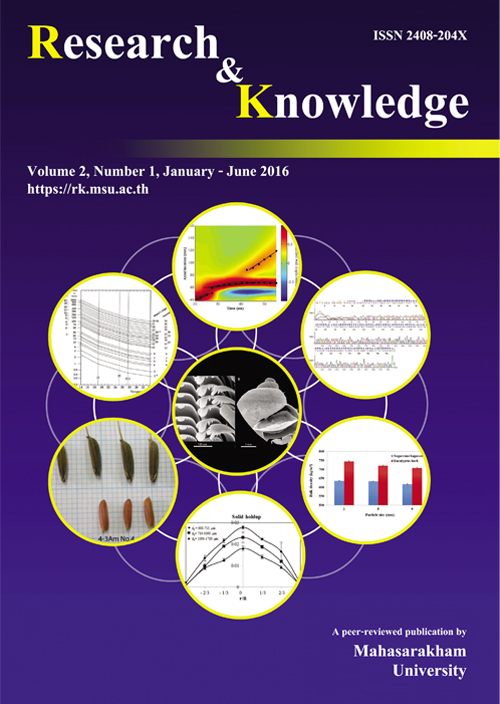Pulse wave propagation and velocity in aneurysmal aorta using FSI model
Keywords:
Aneurysm, heterogeneous aortic wall, pressure wave, stiffnessAbstract
The pulse wave velocity (PWV) has been shown to be associated with the properties of blood vessels and a cardiovascular risk factor, such as an aneurysm. The global PWV estimation is applied in conventional clinical diagnosis. However, the geometry of the blood vessel changes along the wave traveling path and the global PWV estimation may not always detect regional wall changes resulting from cardiovascular diseases. In this study, a fl uid structure interaction (FSI) analysis was applied on straight-shaped aortas with and without an aneurysm with the aim of determining the effects of the aneurysm size and the ratio of the aneurysm to wall modulus on the pulse wave propagation and velocity. The characterization for each stage of the aneurysmal aorta was simulated by progressively increasing aortic stiffness and aneurysm size. The pulse wave propagations and velocities were estimated from a two-dimensional spatial-temporal plot of the normalized wall displacement based on elastic deformation. The supra- and infra-aneurysm PWVs of aneurysmal aortic walls were found to be up to 58±14% and 13±10%, respectively, which were different from the PWV of a normal aortic wall. The combined quantitative and qualitative parameters, i.e., PWV, magnitude of wall displacement on the wave, width of the standing wave and wave propagations, were used to distinguish the characterization of the normal and aneurysmal aortic walls and shown to be relevant regional markers that can be utilized in clinical diagnosis.
References
Baque t, J. P., Kingwell, B. A., Dart, A. L., Shaw, J., Ferrier, K. E. and Jennings, G. L. 2003. Analysis of the regional pulse wave velocity by Doppler: methodology and reproducibility. Journal of Human Hypertension 17, 407-412.
Danpinid, A., Luo, J.,Vappou, J., Terdtoon, P. and Konofagou, E. E. 2010. In vivo characterization of the aortic wall stress-strain relationship. Ultrasonics 50, 654-665.
Fujikura, K., Luo, J., Gamarnik, V., Pernot, M., Fukumoto, R., Tilson III, M. and Konofagou, E. E. 2007. A novel noninvasive technique for pulse-wave imaging and characterization of clinically-signifi cant vascular mechanical properties in vivo. Ultrasound Imaging 29(3), 137- 154.
Humphrey, J. 2002. Cardiovascular solid mechanics: cells, tissues, and organs, Springer-Verlag, New York. Kanyanta, V., Ivankovic, A. and Karac, A. 2009. Validation of a fl uid-structure interaction numerical model for predicting fl ow transients in arteries. Journal of Biomechanics, 42(11), 1705-1712.
Khamdaeng, T., Luo, J., Vappou, J., Terdtoon, P. and Konofagou, E. E. 2012. Arterial stiffness identifi cation of the human carotid artery using the stressstrain relationship in vivo. Ultrasonics 52, 402-411.
Khamdaeng, T., Panyoyai, N.,Wongsiriamnuay, T., and Terdtoon, P. 2015. Pulse wave propagation and velocity in arch-shaped aorta. Rajamangala University of Technology Isan Journal 8, 51-62.
Li, R. X., Luo, J., Khamdaeng, T. and Konofagou, E. E. 2011. Pulse wave imaging (PWI) and arterial stiffness measurement of the human carotid artery: an in vivo feasibility study. In: Proceedings of the IEEE International Ultrasonics Symposium 2011 (IUS 2011), Caribe Royale, Orlando, Florida, USA, pp. 1778-1781. L
uo, J., Fujikura, K., Tyrie, L. S., Tilson, M. D. and Konofagou, E. E. 2009. Pulse wave imaging of normal and aneurysmal abdominal aortas in vivo. IEEE Transactions on Medical Imaging 28, 477-486.
Luo, J., Lee, W. N., Wang, S. and Konofagou, E. E. 2008. Pulse wave imaging of human abdominal aortas in vivo. In: Proceedings of the IEEE International Ultrasonics Symposium 2008 (IUS 2008), Beijing, China, pp. 859-862.
Markl, M., Wallis, W., Brendecke, S., Simon, J., Frydrychowicz, A. and Harloff, A. 2010. Estimation of global aortic pulse wave velocity by fl ow-sensitive 4D MRI. Magnetic Resonance in Medicine 63(6), 1575-1582.
Nichols, W.W. and O’Rourke, M.F. 2005. Mc Donald’s blood fl ow in arteries: theoretical, experimental, and clinical principles, 5th ed. A Hodder Arnold Publication, London, 67-76.
Shahmirzadi, D. and Konofagou, E. E. 2014. Quantifi cation of arterial wall inhomogeneity size, distribution, and modulus contrast using FSI numerical pulse wave propagation. Artery Research 8, 57-65.
Shahmirzadi, D. and Konofagou, E. E. 2012. Detection of aortic wall inclusions using regional pulse wave propagation and velocity in silico. Artery Research 6, 114-123.
Shahmirzadi, D., Li, R. X. and Konofagou, E. E., 2012. Pulse-wave propagation in straight-geometry vessels for stiffness estimation: theory, simulations, phantoms and in vitro fi ndings. Journal of Biomedical Engineering 134(11), 114502.
Shahmirzadi, D., Narayanan, P., Li, R. X., Qaqish, W. W. and Konofagou, E. E. 2013. Mapping the longitudinal wall stiffness heterogeneities within intact canine aortas using Pulse Wave Imaging (PWI) ex vivo. Journal of Biomechanics 46, 1866-1874.
Vappou, J., Luo, J., Okajima, K., Tullio, M. D. and Konofagou, E. E. 2011. Aortic pulse wave velocity measured by pulse wave imaging (PWI): a comparison with applanation tonometry. Artery Research 5, 65-71.
Vappou, J., Luo, J. and Konofagou, E. E. 2010. Pulse wave imaging for noninvasive and quantitative measurement of arterial stiffness in vivo. American Journal of Hypertension 23, 393-398.
Williams, R., Needles, A., Cherin, E., Zhou, Y. Q., Henkelman, R. M., Adamson, S. E. and Foster, F. S. 2007. Noninvasive ultrasonic measurement of regional and local pulse-wave velocity in mice. Ultrasound in Medicine & Biology 33(9), 1368-1375.
Downloads
Published
How to Cite
Issue
Section
License

This work is licensed under a Creative Commons Attribution-NoDerivatives 4.0 International License.








